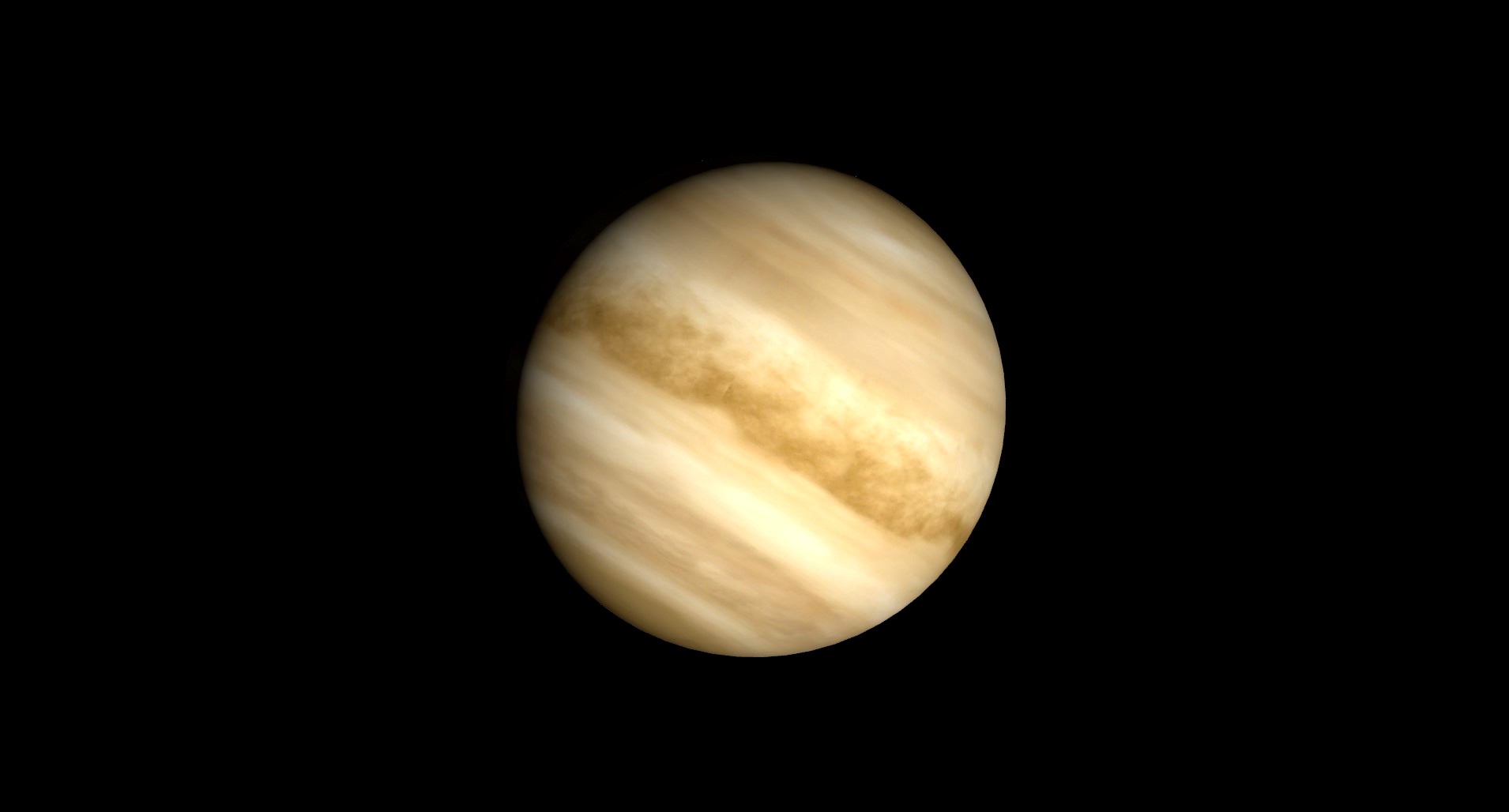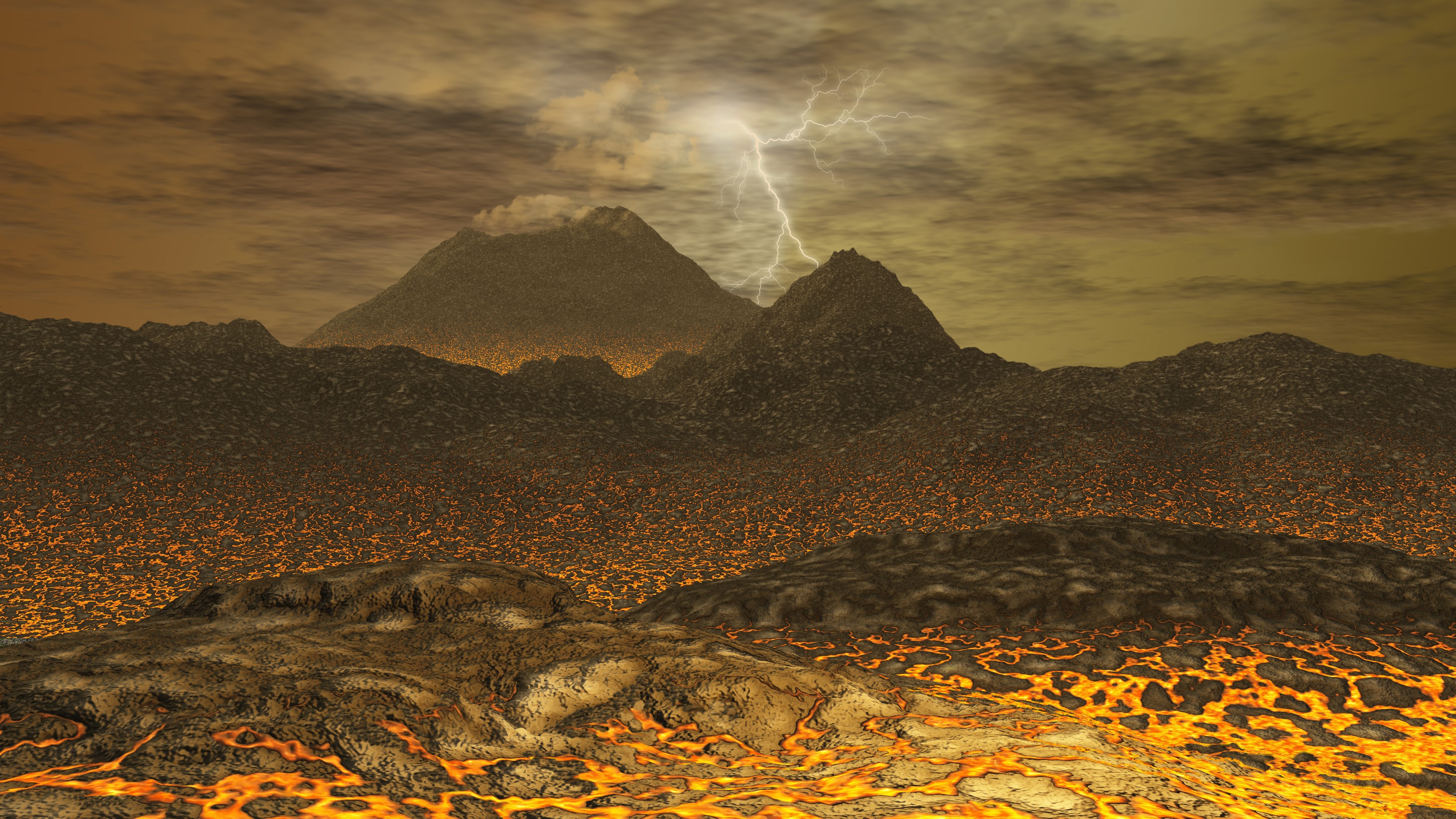Venus may be able to support life, new atmospheric evidence suggests
"Whether it's in penguin poop or badger guts, we don't know why bacteria make phosphine, but they do."

New preliminary evidence for phosphine and ammonia in Venus's atmosphere deepens the mystery behind what is producing these gases. The puzzling origin of phosphine and now ammonia means that the idea that these chemicals may have a biological source on Venus is under serious consideration by some scientists.
Venus seems like an unlikely place to find life due to its blisteringly hot surface temperatures sufficient to melt lead and its fearsome surface pressure. The presence of phosphine and ammonia in the clouds of the second planet from the sun and the hottest planet in the solar system implies that if life could exist there, it would be found high above the Venusian surface.
The new detections of phosphine and ammonia were obtained by a team led by Jane Greaves of the University of Cardiff using submillimeter radio wavelength data collected by the James Clerk Maxwell Telescope (JCMT) in Hawaii and the Green Bank Telescope in West Virginia.
"We don't know how you make phosphine or ammonia in an oxygenating atmosphere like that of Venus," said team member and astrophysicist Dave Clements of Imperial College, London, in an interview with Space.com. Then again, it's not clear why biology on Earth produces phosphine, either." Whether it's in penguin poop or badger guts, we don't know why bacteria make phosphine, but they do."
Related: Life on Venus? Intriguing molecule phosphine spotted in planet's clouds again
Phosphine detection over Venus generates controversy
The JCMT’s initial detection of phosphine on Venus in 2020 by Greaves and her team was met by fierce disagreement from some quarters.
This disagreement focused on how the data was processed and whether that was creating spurious signals since observations by other telescopes struggled to detect the phosphine.
Get the Space.com Newsletter
Breaking space news, the latest updates on rocket launches, skywatching events and more!
Clements said those technical disagreements have now been resolved and that the latest measurements, using a new detector on the JCMT called Nāmakanui (meaning ‘Big Eyes’ in Hawaiian), have come from three observing campaigns, each providing 140 times as much data as the initial detection.
Clements said those technical disagreements have now been resolved and that the latest measurements, using a new detector on the JCMT called Nāmakanui (meaning 'Big Eyes' in Hawaiian), have come from three observing campaigns, each providing 140 times as much data as the initial detection.
"Nāmakanui is a suite of three different receivers at three different frequencies," said Clements.
One of those receivers, called ‘Ū’ū (the name of a particular big-eyed fish that can see in the dark in the waters around Hawaii), is able to detect phosphine, as well as sulfur dioxide and "semiheavy water" (HDO), water with one hydrogen atom and one "heavy hydrogen" atom, or deuterium, rather than two hydrogen and the usual one oxygen atom. Both sulfur dioxide and HDO vary with time in the clouds of Venus, and Greaves and Clements’ team want to see how phosphine varies, too.
"There are suspicions, possibilities, that the amount of phosphine might vary with time, but we don’t know what drives the variability," said Clements.

One possibility is ultraviolet light from the sun breaks up molecules in the upper atmosphere of Venus, causing variability in phosphine.
Clements pointed out that the initial detection of phosphine came when JCMT was observing the morning terminator on Venus, where the planet's nightside was turning into its dayside. At night, solar ultraviolet light would not have an impact, allowing phosphine to build up.
The other observations, by the European Space Agency’s Venus Express spacecraft, SOFIA (the Stratospheric Observatory for Infrared Astronomy), and NASA’s Infrared Telescope Facility in Hawaii, observed Venus when the day was turning into night, and solar ultraviolet could have already broken up much of the phosphine, and so they struggled to detect it.
Clements has since reanalyzed the SOFIA data and found a faint hint of phosphine present. Rakesh Mogul at California State Polytechnic University also found phosphorus in high abundance when reanalyzing the mass spectrometer data from the old Pioneer Venus mission of 1978.
"If phosphine is being destroyed by solar ultraviolet, that’s consistent with these other observations not finding it," said Clements. It also suggests that the phosphine is quickly being replenished by some unknown process.
Then there’s the ammonia.
Could ammonia make Venus more habitable?
Detected at Venus by the Green Bank radio telescope, the origin of ammonia is as murky as that of phosphine. If its presence in Venus’ atmosphere is real, however, it could give microbial life a way to survive in the extreme conditions there.
One barrier to imagining how life could survive in Venus' atmosphere is the sheer acidity of the environment, with clouds of pure sulfuric acid. Even though the temperature at an altitude of 31.6 to 38.5 miles (51 to 62 kilometers) is temperate, as opposed to the sweltering 870 degrees Fahrenheit (465 degrees Celsius) on the surface, nobody can see how life could survive the acidity.
Ammonia provides a way for life to do that. When mixed with sulfur dioxide, the ammonia neutralizes some of the acidity.
"It's still horrifyingly acidic," said Clements. "But it makes the droplets compatible at least with some acidophilic extremophile life that we know exists on Earth."
Life's ability to survive such conditions has also recently been supported by the discovery that amino acids can remain stable amid high concentrations of sulfuric acid.

It is still possible that both phosphine and ammonia detected around Venus have a more mundane explanation. After all, both are found in the atmospheres of the gas giants Jupiter and Saturn.
On these solar system gas giants, these chemicals are formed deep in the hydrogen atmosphere under extremely high pressure and high-temperature conditions before being brought to the cloud tops by upwelling convection currents.
The problem is we would expect to find phosphine (which is made from phosphorous with three hydrogen atoms) and ammonia (composed of one nitrogen atom with three hydrogen atoms) in hydrogen-rich atmospheres such as those of Jupiter and Saturn.
"But if you're in an oxygenating atmosphere, like Venus or Earth, everything should be bound to oxygen," said Clements. "As soon as you’ve got any free hydrogen, it's going to react with something involving oxygen. We haven’t investigated the chemical pathways to produce ammonia as much as we did with phosphine because the result is so new, but I fully expect it to be exactly the same problem."

Clements is open to the possibility that both phosphine and ammonia are being produced by some rare photochemistry in Venus’ upper atmosphere involving solar ultraviolet breaking up molecules and allowing phosphine and ammonia to form from the molecular debris. If that is the case, nobody has observed this process yet, not even in the laboratory.
Another possibility that has been mooted is that the phosphine could be produced by Venusian volcanoes.
Clements also pointed out that the European Space Agency's Jupiter Icy Moons Explorer (JUICE) is making a fly-by of Venus in August 2025 to help slingshot it towards the Jovian system. JUICE carries instruments capable of detecting phosphine and ammonia, but there’s no guarantee that its instruments will be switched on and deployed at Venus.
"We're still trying to convince the engineers, who don't like to turn things on mid-flight," said Clements.
So, the existence of phosphine and ammonia in Venus' atmosphere may remain debatable, even controversial, for some time yet. Given the possible implications for life, the stakes couldn't be higher.
The team's findings have not yet been peer-reviewed or published. While other scientists have not been able to scrutinize them yet, they were previewed in presentations at the National Astronomy Meeting 2024 in the UK in July.
Editor's note: HDO contains one hydrogen atom and one deuterium atom, which are heavy hydrogen atoms, not three hydrogen atoms as originally stated.
Join our Space Forums to keep talking space on the latest missions, night sky and more! And if you have a news tip, correction or comment, let us know at: community@space.com.

Keith Cooper is a freelance science journalist and editor in the United Kingdom, and has a degree in physics and astrophysics from the University of Manchester. He's the author of "The Contact Paradox: Challenging Our Assumptions in the Search for Extraterrestrial Intelligence" (Bloomsbury Sigma, 2020) and has written articles on astronomy, space, physics and astrobiology for a multitude of magazines and websites.
-
Unclear Engineer The article is incorrect where it states "HDO), water with three hydrogen atoms rather than two and the usual one oxygen atom."Reply
This "semi-heavy water" is 2 hydrogen atoms and one oxygen atom. The "D" is the deuterium version of hydrogen, and has a neutron in its atomic nucleus as well as the single proton that makes it hydrogen.
What we call "heavy water" is D2O, with both hydrogen atoms having the extra neutron. -
Unclear Engineer Reply
Of course. What is incorrect is saying that there are 3 hydrogen atoms in the HDO molecule.Gibsense said:Would I be correct to say that deuterium is an isotope of hydrogen; maybe? -
Torbjorn Larsson Here is a pessimist converting to optimist under the new data:Reply
From a scientific perspective, the new data about phosphine and ammonia is intriguing but warrants cautious optimism, said Javier Martin-Torres, a professor of planetary sciences at the University of Aberdeen in the United Kingdom. He led a study published in 2021 that challenged the phosphine findings and postulated that life isn’t possible in the clouds of Venus.
https://edition.cnn.com/2024/07/29/science/venus-gases-phosphine-ammonia/index.html
“Our paper emphasized the harsh and seemingly inhospitable conditions in Venus’s atmosphere,” Martín-Torres said in an email. “The discovery of ammonia, which could neutralize the sulfuric acid clouds, and phosphine, a potential biosignature, challenges our understanding and suggests that more complex chemical processes might be at play. It’s crucial that we approach these findings with a careful and thorough scientific investigation.”
This is ever more interesting! Besides the gases we have the cell sized radio signal disperser at roughly the habitable cloud layer height.
Meanwhile, the correlation between Earth and Venus is getting stronger, since at least the smallest of the two more validated venusian "continents" seems indeed be a craton:
The Ishtar Terra highlands on Venus consist of Lakshmi Planum, an Australia-sized crustal plateau with an average elevation of ~4 km that is comparable to that of the Tibetan Plateau, surrounded by elongated mountain belts with elevations of around 10 km, taller than the Himalayas. The region is floored by thick crust that is comparable to that of cratons on Earth. On Earth, plateaus and mountain belts result from the collision of tectonic plates. However, the origin of Ishtar Terra remains enigmatic because Venus lacks Earth-like plate tectonics. Here we use three-dimensional thermo-chemo-mechanical computational simulations of Venus-like mantle convection to show how magmatism and tectonics emerge from mantle dynamics. The simulations show that a lithosphere weakened as a result of high initial hydration or high surface temperatures enhances convective thinning and decompression melting, favouring the emplacement of a thick magmatic crust on top of a deep residual depleted mantle. The stiffer residual root deflects mantle flow outwards, leading to the formation of fold belts around the buoyant lithosphere that are consequently uplifted into a plateau and preserved from further deformation. The modelled topography, crustal thicknesses and gravity is consistent with observational constraints of Ishtar Terra. Our findings suggest that plateau formation on Venus may operate similarly to craton formation on the hot early Earth, before the onset of plate tectonics.
https://www.nature.com/articles/s41561-024-01485-3









